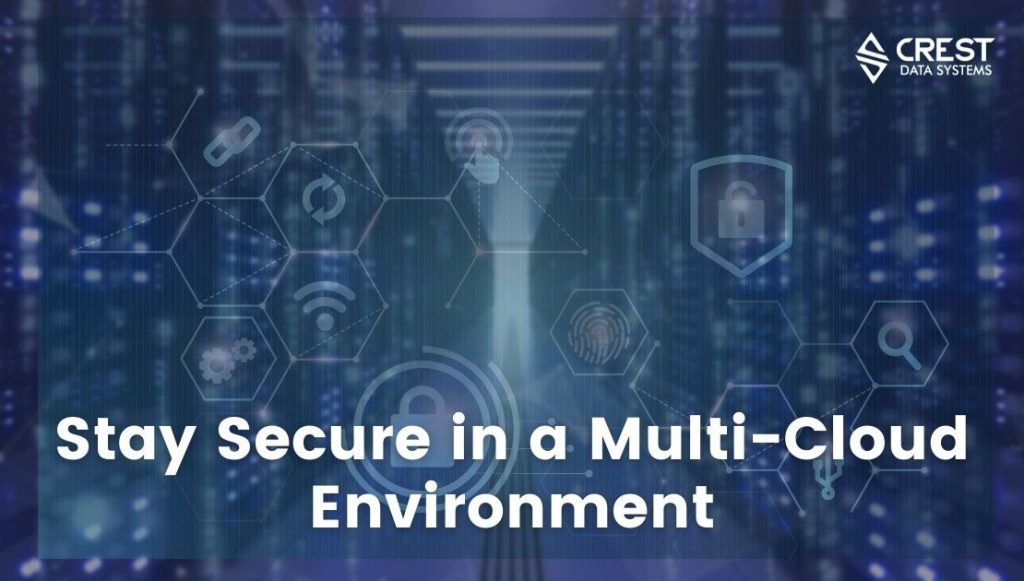Stay Secure in a Multi-Cloud Environment

Security is top of mind in today’s evolving business landscape. Companies require the scalability and flexibility that a multi-cloud environment offers but securing it demands the same amount of focus.
More businesses are moving towards and adopting a multi-cloud strategy. Gartner states that,
“Most organizations adopt a multicloud strategy out of a desire to avoid vendor lock-in or to take advantage of best-of-breed solutions” – Michael Warrilow, VP Analyst, Gartner.
Deploying multiple cloud solutions to meet different business or technical requirements and using different components and services offered by different platforms is the advantage of a multi-cloud environment.
While this digital transformation trend will surely continue, what challenges may companies face and what are some ways we can work to mitigate? In this article, we’ll explore different approaches and how to stay secure in a multi-cloud environment.
The Challenge with Multi-Cloud
The adoption and deployment of multi cloud strategies is becoming ubiquitous and is more commonplace across the business landscape. Managing the security of the different workloads across the many cloud platforms is a demanding but necessary task for teams. Let’s discuss some challenges teams will face with a multi-cloud deployment.
Complexity – This is the most common one. Introducing multiple solutions offered by different providers to solve business and technical problems inherently creates a set of new challenges.
Environments today are often layered with different applications and systems working with dependencies. The process of managing and processing data from different cloud vendors and diversity of services deployed will add challenges for your team.
Having visibility and securing this complex infrastructure becomes a large effort. An organization will need observability and monitoring tools to have a holistic view of the architecture to make better informed decisions and resolve any issues effectively.
Many cloud providers lead with a “one cloud to rule them all” rhetoric but studies show that many organizations still deploy multi-cloud solutions. For example, approximately 33% of the total market uses AWS as their primary cloud provider, but within this group, many companies still have at least some workloads running on Azure or another cloud.
This creates complexity that has an impact on an organization’s operational workflow. Securing a single cloud solution can be demanding but ensuring an multi-cloud environment is secure can seem overwhelming to say the least.
Operational – Another is the operational challenges that come along with a multi-cloud environment. According to a study by Statista, the most pressing operational challenge for enterprises with multiple clouds is the consistent security, access control, and compliance needed, with 35% of respondents answering as such. This is due to the overall complexity surrounding a multi-cloud environment, with the potential for fragmented silos, data gravity,and prohibitive egress expenses.
Interoperability – As organizations adopt cloud solutions and migrate from legacy platforms and applications, the challenge of fitting all the pieces and ensuring that all work together can be difficult for technical teams. It is common to have different applications and cloud platforms to meet the evolving business and technical requirements and demands of an organization. Though with this evolution, teams need to introduce cloud security tools (cloud workload protection, cloud security posture management, cloud identity and entitlement management) to help secure the multi-cloud infrastructure.
Public Cloud Shared Responsibility Model – The challenge of the Shared Responsibility Model of public clouds is a common one. This is where providers comply with a shared security responsibility model. How it works is your security team will manage some security responsibilities over applications, workloads, and data of the environment and the cloud provider maintains some as well. But the challenge is defining the responsibilities and where to draw the line.
But don’t worry, the business and technical advantages of multi-cloud adoption surpasses the challenges discussed above. There are steps companies can take to help address these challenges and be more secure. Let’s explore some best practices and options available to secure your cloud operations.
Simplify
This may seem obvious but to reduce the complexity of a multi-cloud environment is to simplify. The interoperability of systems may help with growth and productivity but should be balanced with an infrastructure that your team can manage and maintain.
Adopt comprehensive tools that offer a holistic view of your entire cloud, this will help security analysts to be more effective at determining system misconfigurations or possible data breaches. Tools that have cloud native AI and ML capabilities that can detect anomalies and give prioritized alerts so your security team can resolve serious threats and have less alert fatigue.
Another step is to simplify your environment by taking an assessment of your systems to determine which application is crucial for your team to perform. Reducing dependencies is another way to clean house and simplify your infrastructure.
Automate
Cloud automation refers to processes and tools that reduce or eliminate manual efforts used to provision and manage cloud computing workloads and services. This enables administrators to more efficiently deliver results on processes that would normally take much more time and resources if done manually. Teams can focus on higher priority efforts by removing the tedious or repetitive tasks from the workflow.
Configuration errors are one of the largest challenges in the cloud which often lead to security issues. The Global Risks Report released by the World Economic Forum states that 95% of cybersecurity breaches are caused by human error.
Operating a multi-cloud environment demands the need to address the different capabilities of each cloud. Implementing automation policies helps to reduce human errors, improves consistency, and streamlines your operations increasing ROI for the company.
The optimization and adaptability of automated processes will have a positive impact on the company’s entire business performance. The team will get more time everyday to focus on growth when operations are autonomous where possible.
Implement and Impose Security Policies
Security polices are the clear, formal, well specified plans that includes rules, guidelines, processes and practices that an organization adheres to that regulates and helps ensure secure operations in the cloud.
Gartner predicts that through 2024, the majority of enterprises will continue to struggle with appropriately measuring cloud security risks.
Through 2025, 90% of the organizations that fail to control public cloud use will inappropriately share sensitive data. – Gartner
Implementing and enforcing strict security policies for your organization is an important step to mitigating data breaches and security threats and will increase the company security posture as a whole. It is also important that the individual teams are trained on the policies and practice strong zero-trust cybersecurity practices to build a cybersecurity aware culture.
Comprehensive Security Tools
Implementing a comprehensive security solution should not be seen as an option anymore but a necessity. It’s fundamental that every single byte of data stored is safe from compromises, threats and any form of breach. For some perspective, nearly 19,000 terabytes of data are exposed by unsecured databases and close to 90% of the breaches associated with cloud solutions involve compromised privileged credentials.
While some organizations understand the importance of a robust and proactive security solution. According to statistics, close to 64% of the organizations admit to lacking confidence in their cybersecurity postures.
Be sure your team understands and familiarize themselves with the landscape and different offerings security vendors provide today. Many vendors offer managed security solutions with cloud-native monitoring, detection, and response capabilities leveraged with AI and ML.
Security providers can provide autonomous high fidelity investigations to increase your company’s cybersecurity resilience with prioritized alerts to reduce alert fatigue for your team. Many vendors offer all of this in a SaaS model tiered to fit your technical requirements and business goals.
Choosing the right vendor for your organization’s security needs will increase the company’s security posture, ensure compliance, and give teams and customers confidence and peace of mind.
Next Steps
Crest Data Systems has worked with Fortune 500 companies as well as some of the world’s most innovative companies and hottest startups to streamline work processes so teams can perform at their highest level.
Contact us to learn more about our Product Engineering solutions and our broad range of managed and professional services that encompass solution implementation, building integrations,enable migration, health checks, and see how we can help you today.

AUTHOR –
TUAN NGUYEN
Tuan is a Product Marketing Manager with 8+ years of industry experience in large Enterprise technology companies and start-up. He is passionate about technology marketing and has experience in Cybersecurity, Cloud Security, and Data Center Networking.

